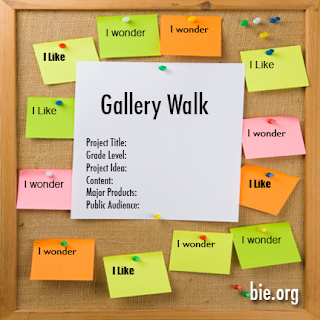C4T #1 Summary #1 - Start the Year with a Project... or Wait?
John Larmer is the Editor in Chief of the Buck Institute of Education and is one of the main contributors to the blog Experts & New BIEs. He gives an excellent example of how to encourage students to think for themselves. In the piece Start the Year with a Project... or Wait?, Mr. Larmer recommends that students who are familiar with Project-Based Learning (PBL) should be given challenges as soon as the second day of class. However, if students have not had much experience with Project-Based Learning, gradual steps should be taught so that the students will be able to perform these tasks by themselves or in a collaborative group. There are "4 C's" that are recommended that we teach our students in order to make them more capable of PBL.
The first of the "4 C's" is critical thinking. Ways to engage students in critical thinking practices is to get them to solve puzzles or answer open-ended questions in which they must think of in length. Give students scenarios and ask which ways they could think to improve it. We could also simply ask them how they would define critical thinking in their own words. Another of the "4 C's" is collaboration. Our students need to learn how to work with others. They need to learn how to share ideas as well as listen to the ideas of others. Teamwork is much more capable of greatness due to the differences in the way we all think. In cases of extreme greatness, great minds do not think alike but rather collectively.
Communication is the third of the "4 C's" with which we should be familiarizing our students. We need to get them used to speaking and listening to their fellow peers. Have them learn to speak in front of others, present ideas, and answer questions that his/her peers may have. The last of the "4 C's" is Creativity and Innovation. Students need to know that thinking outside of the box is exactly how progress is made. They need to understand that the great inventors of our time have only been that due to the creativity they allowed to flow from them. We as a nation would never go forward if we didn't have someone who was creative and innovative enough to come up with ideas never thought before.
Mr. Larmer ended his blog with a reminder that it is very important that we create a classroom where students feel they can speak their ideas and not feel the pressure of negative comments from instructors or peers. Feedback is a must whether it be constructive or complementary, but it should never come across in a negative manner. We must create classrooms that encourage and reward abstract thought and communication.
C4T #1 Comment #1
My name is Danya Croft and I am a student at the University of South Alabama. I am majoring in Secondary Science Education. I love the idea of teaching students how to problem-solve for themselves rather than depending on teachers or peers to tell them the answers to everything. It is very important for students today to learn how to learn. I feel that the steps you have listed are excellent ways to start implementing Project-Based Learning inside of my classroom. I am not a teacher yet, but I am already trying to organize my classroom in theory so that when I actually get started I will have a better idea of what will work best.
C4T#1 Summary #2 - Using Gallery Walks for Revision and Reflection
In Using Gallery Walks for Revision and Reflection, Charity Allen and John Larmer team up to enlighten readers of an excellent, interactive alternative to sharing thoughts and ideas that teachers, classmates, and experts have about the work of a student. Students post their work in an art gallery format so that people can walk around to reflect on the pieces. "Our version of a Gallery Walk protocol doesn't take much time; it provides a structure for critique; and it levels the playing field, since participants are both givers and receivers of feedback."
They deduced that giving a certain set of components to look for made leaving feedback much easier and of higher quality. The feedback was based on: project title, grade level, project idea (summary of main purpose), driving question, content (summary of key topics), major products (what students will create), and public audience (who will see & hear presentations or use products). The feedback "I like..." and "I wonder..." was given by leaving post-it notes around the board to express the positive aspects as well as the aspects that need additional attention. These Gallery Walks were intended to be informative and helpful. Allen and Larmer feel that a Gallery Walk is an excellent tool to improve the effectiveness of Revisions and Reflections.
C4T #1 Comment #2
I think this is an amazing opportunity to engage students in the revision and reflection process. Too many times, students bypass commenting on mistakes/errors on the project of a peer due to not wanting to hurt his/her feelings or seem too critical. However, the Gallery Walk allows for many peers at one time to leave a positive comment as well as a reflective comment. Something that I noticed about this tool is that each project viewed will have the same number of comments. Students will have no reason to feel embarrassed or upset about the feedback because everyone will have the same amount of feedback. Also, I think this will be an excellent way to keep intact the self-confidence of the students and encourage them to keep bettering themselves with every project.



No comments:
Post a Comment